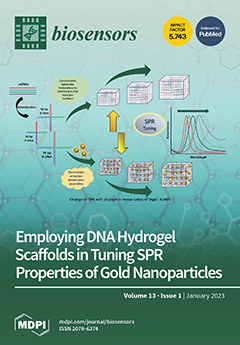A highly sensitive, biocompatible, and scalable phosphorescent oxygen sensor formulation is designed and evaluated for use in continuous metabolite sensors for biological systems. Ethyl cellulose (EC) and polystyrene (PS) nanoparticles (NPs) stabilized with Pluronic F68 (PF 68), Polydimethylsiloxane-
b-polyethyleneglycol methyl ether (PDMS-PEG),
[...] Read more.
A highly sensitive, biocompatible, and scalable phosphorescent oxygen sensor formulation is designed and evaluated for use in continuous metabolite sensors for biological systems. Ethyl cellulose (EC) and polystyrene (PS) nanoparticles (NPs) stabilized with Pluronic F68 (PF 68), Polydimethylsiloxane-
b-polyethyleneglycol methyl ether (PDMS-PEG), sodium dodecylsulfate (SDS), and cetyltimethylammonium bromide (CTAB) were prepared and studied. The resulting NPs with eight different surfactant–polymer matrix combinations were evaluated for physical properties, oxygen sensitivity, effect of changes in dispersion matrix, and cytotoxicity. The EC NPs exhibited a narrower size distribution and 40% higher sensitivity than PS, with Stern–Volmer constants (
Ksv) 0.041–0.052 µM
−1 for EC, compared to 0.029–0.034 µM
−1 for PS. Notably, ethyl cellulose NPs protected with PF68 were selected as the preferred formulation, as they were not cytotoxic towards 3T3 fibroblasts and exhibited a wide phosphorescence lifetime response of >211.1 µs over 258–0 µM and ~100 µs over 2.58–0 µM oxygen, with a limit of detection (LoD) of oxygen in aqueous phase of 0.0016 µM. The EC-PF68 NPs were then efficiently encapsulated in alginate microparticles along with glucose oxidase (GOx) and catalase (CAT) to form phosphorescent nanoparticles-in-microparticle (NIMs) glucose sensing microdomains. The fabricated glucose sensors showed a sensitivity of 0.40 µs dL mg
−1 with a dynamic phosphorescence lifetime range of 46.6–197.1 µs over 0–150 mg dL
−1 glucose, with a glucose LoD of 18.3 mg dL
−1 and maximum distinguishable concentration of 111.1 mg dL
−1. Similarly, lactate sensors were prepared with NIMs microdomains containing lactate oxidase (LOx) and found to have a detection range of 0–14 mg dL
−1 with LoD of 1.8 mg dL
−1 and maximum concentration of 13.7 mg dL
−1 with lactate sensitivity of 10.7 µs dL mg
−1. Owing to its versatility, the proposed NIMs-based design can be extended to a wide range of metabolites and different oxygen-sensing dyes with different excitation wavelengths based on specific application.
Full article






